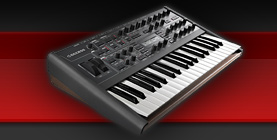

|
|||||||
| General discussion about Access Virus Discussion about Virus A, B, C and TI. |
 |
|
|
Thread Tools | Search this Thread | Display Modes |
|
#1
|
||||
|
||||
|
So how does this work, then?
Does it duplicate the waveform, and then variably adjust the phase of the duplicate against the original (a bit like a chorus effect)? ...Like something that was discussed a few years ago (pseudo PWM): http://www.infekted.org/virus/showth...ht=pulse+width (pictures and audio demos of which are further down the page). Or is it different to that technique? Any demos to showcase the effect? The only bit I've heard of the TI's PWM wavetables was from the January 2007 TIOSv2 youtube demo by Ben Crosland at NAMM last year, which was isolated and a little quiet, and I couldn't really discern it properly. Cheers.
__________________
PS > And another thing! Will the Ti|3 have user customisable/importable wavetables? Last edited by Timo : 08.12.2007 at 05:48 PM. |
|
#2
|
|||
|
|||
|
I know there is a description somewhere.
Will try to find it for you. If anyone has the TI software then please post it |
|
#3
|
||||
|
||||
|
Just found a description from the V2 addendum:
Quote:
"PulseWidth - At zero position, all the even-numbered harmonics are cancelled out, creating a hollow sound similar to a 50% pulse wave - then the value reaches 127, the whole wave is almost entirely cancelled out, resulting in a much thinner sound." ... isn't the same. Whereas on my audio example of Korg's implementation of waveform modulation the two saw waves rocked between a standard saw wave and one an octave higher, at no point would they ever cancel each other out. It appears that Access' do the same, but they mirror the duplicate wavetable on the x-axis (flip it upside down) before phase-shifting it with the original wavetable. That way the waveforms WILL cancel each other out depending on the phase, like true PWM. It would sound markedly different to something like the original audio example of Korg's implementation of the waveform modulation (which sounds really nice and brass-like), but I guess the options on the Access implementation are much more flexible - being indiscriminate in the waveforms that the effect can be applied to (Korg's was limited to the saw waveform only. - Of that I can think of [and it's a bit of a headfuck] I don't think any other waveform apart from a sawtooth can effectively be pitched up an octave by duplication and phase-shifting while still retaining the identical sonic characteristic of the original?). Would be very interested to hear what the Access PWM implementation sounds like anyway. By the way, what are the waveforms like on the wavetables? Are they anything like the LFO waveforms? Cheers.
__________________
PS > And another thing! Will the Ti|3 have user customisable/importable wavetables? |
|
#4
|
|||
|
|||
|
some of them are very strange, but listening to them alone I get more of a bell like sound coming from most. However I have been shown that some wonderfull things can be done with them. I just have to wait until I can program patches better before I can use them to their potential.
As far as how they look compared to the LFO's nobody has pic's yet, but I know they're just one cycle samples. They all have daft names that don't describe the shape so hard to tell. Maybe a quick look on a scope will help me describe them, will see if I can get time. |
 |
«
Previous Thread
|
Next Thread
»
| Thread Tools | Search this Thread |
| Display Modes | |
|
|
 Similar Threads
Similar Threads
|
||||
| Thread | Thread Starter | Forum | Replies | Last Post |
| Virus b Wavetable FAQ? | Dan | Sound designing | 11 | 23.10.2019 08:32 PM |
| matching oscillator tones | the_bod | Sound designing | 53 | 29.10.2004 05:35 PM |
| VA oscillator differences | r3dnaX | Sound designing | 24 | 17.08.2004 08:41 PM |
| Oscillator 3 | Szathy | General discussion about Access Virus | 1 | 17.03.2004 12:08 PM |
All times are GMT. The time now is 10:01 PM.
Powered by vBulletin® Version 3.6.4
Copyright ©2000 - 2025, Jelsoft Enterprises Ltd.
Skin Designed by: Talk vBulletin
Copyright ©2000 - 2025, Jelsoft Enterprises Ltd.
Skin Designed by: Talk vBulletin
Copyright ©2002-2022, Infekted.org
 |
 |







 Linear Mode
Linear Mode

